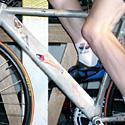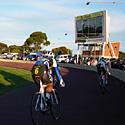
Recently on Cyclingnews.com |
Introduction to Track Racing - What's a Wheelrace? - Introduction to Six Day racing
Tasmanian Christmas Carnivals
Tasmania, December 26, 2004 - January 1, 2005
Special feature: Inside the carnivals
Part two: Half a world away
In the second part of our in-depth look at the Tasmanian Carnivals, Gerard Knapp talks to visiting international riders about the appeal of these unique events and examines the way forward as organisers work to balance tradition and development. Back to part 1.

|
Each year, a handful of Japanese riders will make their way out to Tasmania. Track racing is huge in Japan, as long as it involves keirin racing and gambling. However, the riders who come to Tasmania are not the rich superstars of the Japanese keirin circuit, where a rider can pocket up to US$1 million for one race.
It seems Japanese track riders have two career paths; they can either spend their lives making serious dollars in the keirin circuit, but otherwise be somewhat outclassed in open competition against the Ryan Bayleys and Theo Boses of the world. Or, they can aim for the warm inner glow of racing against the best in the world and not making much at all.
"Here, the audience love cycling."- Emerging Japanese sprinter, Takashi Kawamura, about the difference between keirin crowds in Japan and the spectators in Tasmania. |
But performing for the people who love the sport has its appeal to Takashi Kawamura, 20, a first-timer in Tasmania in 2004. The emerging sprinter has been a leading amateur in the Asian Cup, a track series in several Asian countries. Yet he's found the going tough in Tasmania and indeed, crashed heavily in Devonport. Still, he was very enthusiastic about the learning experience and the variety of racing on offer.
Riders can enter a 200m time trial - Kawamura did an 11.9 in Devonport in windy conditions, "not good racing time!", he laughed - through to a 16km scratch race, or sometimes a 20km Madison. The keirin is not raced too often at the outdoor tracks at the Carnivals; it's not traditional, after all.
The university student is tossing up between his two apparent choices to develop as a rider, and he clearly enjoyed the atmosphere of racing in front of crowds who are there for the racing, not to make money.
"I wonder how many riders know that we offer $100 to any non-contracted mainland rider to attend?"- Grant Atkins, SCAT chairman |
Keirin track meets in Japan are primarily attended by hard-core gamblers, not cycling fans: "They're only betting people, [so it's] not the same atmosphere." There are 3000 registered keirin racers in Japan and making a living is not a remote chance, but "here, the audience love cycling," and for this emerging rider, that makes a big difference.
He was being chaperoned, to some extent, by countryman Koji Youshii, 34, a regular at the Carnivals. Between events, Youshii is popular among the crowd, so well-known by the locals that he held the infant child of another racer as if it were his own.
Incentives to riders
The child was none other than Willam Atkins, a son of racer Grant Atkins, who in turn is the offspring of Grant Atkins, the chairman of SCAT, the Sports Carnivals Association of Tasmania. Atkins Snr. was also at Devonport, watching the racing, with his family, which seems to include invited racers.
Tasmanians are hospitable people and they invite any licensed rider to race. They even get an incentive to enter.

|
"I wonder how many riders know that we offer $100 to any non-contracted mainland rider to attend?" Atkins asked, when discussing the ongoing development of the Carnivals as they head into 2005.
Himself a very good track rider, Atkins stopped to watch Kersten wind up to over 65kmh in an attempt to break the flying 200 metre time trial, a sprinters' specialty. "We could see something special here."
Kersten missed breaking Sean Eadie's record, but Atkins was very pleased with the young rider, a late replacement for multiple world champion, Shane Kelly. Kersten had been entertaining the crowds and putting in many solid rides.
For Kersten - and other Sydney rider Rochelle Gilmore (see her diary) - they arrived early in Tasmania on the 26th, leaving their homes after a typical Christmas Day. Then it's straight into racing at Latrobe.
"I think I went 24 hours without sleep and 10 races without food. I felt so dead I thought it was over," he said of his first performances. However, he'd bounced back with some rest and sustenance and was winning at will. "You can't get better training than racing," he said.
As long as it fits into a rider's program. It could be that the recent changes to the UCI international program, with the world championships set down for March and the track world cup beginning late the previous year, could only benefit the Carnivals, which slots into the middle of the world cup rounds. This year, however, the Manchester, UK, round runs January 7-9 and the Sydney event is on February 18-20. If the UCI swapped dates of the Manchester round with Sydney, then Tasmania could find a whole new source of riders.
If riders are not already into form by the third round of the world cup, then they must be close to it, and speed work is likely to be the order of the day.

|
Kersten had impressed in Tasmania with not only his speed, but apparent endurance. He not only won the short events, but also stayed with the high-speed bunch in the 16km A grade scratch race - a field that included Brown, Hutchinson, Carney, German Olympian Christian Lademann, and so on - before hitting his after-burner on the last lap with 250m to go.
It would appear that his hunger is nowhere near quenched, motivated no doubt by the tumultuous year of selection/rejection/bench-sitting for the Australian Olympic team.
Kersten was to leave the Carnivals to attend his brother's wedding, but gave value for money, it would seem. He paid credit for his form due to the support from coach Gary Sutton, gym coach Dave Clark and sports scientist Kenneth Graham.
Kersten will next head to Manchester for the track world cup and he's also excited at being one of the 24 riders invited to take part in a demonstration keirin, co-organised by the Japanese Keirin Association, to be held at the end of the main world cup program.
But unlike the UCI's world cup, there is some 45,000 pounds sterling up for grabs, with £15K for first place. He estimated he could make more in one race than six previous years of racing.
The big names

|
Attracting the big names is important to keep the gate traffic high, but the Carnivals are open for all licensed riders to enter. Atkins said that the cash incentive to mainland or overseas riders is just one of the many reasons they should consider attending. He said it's likely the committee will look at working with travel agents to offer specific packages for track cyclists, covering transport and accommodation in the towns that hold the carnivals.
"If they get in early enough they can get a very good air-fare and it becomes quite reasonable to attend," he said.
So far, it had been a good series for the Tasmanian riders at the Carnivals and also on the road, with the Launceston International Classic street criterium taken out by local teenager (and junior world Madison champion), Matt Goss, against a quality field. Stuart O'Grady ran second as Goss' Tasmanian team-mates put the visiting pro riders - such as McGee, McEwen, Evans, etc - to the sword (see report).
"He's the next big thing in Tassie, no doubt about that," Atkins said of Goss, who was also competing in the Carnivals. "He could get signed up for a big road team and we'll never see him again," he said.
"We've had them all racing here over the years, riders like O'Grady, (Luke) Roberts … a lot of the big names".
Atkins and the SCAT committee face the task of maintaining the carnivals' undoubted traditions, but also being relevant and attractive to athletes in 2005. He believes he has a great product to sell, and Tasmania is a popular tourist destination for not just mainland Australians, but also Europeans and Asians.
"We must never get away from what it's about," he said of the Carnivals' formula. "Keep the three disciplines and bring top-line competitors to regional Australia for a very good price. You pay $15 here to see something that would cost at least $40 in a capital city," he said.
As with any committee-run event, there are many interests to accommodate and that perhaps is their biggest challenge - reaching agreement on introducing new events or formats that appeals to the traditionalists, while attracting the newcomers. Cycling is seen as one of its strengths and it certainly does boast the world-class fields - it's also important to make it easier for competitors and family and friends to make the journey across, Atkins said.
While the prize money and crowds give the riders incentive to perform, American cyclist and Carnivals regular, Jame Carney, said, "you guys [Australians] have a screwed-up prize list. In the US, we're not allowed to give more than 29 percent [of the total prize money] for first place. Here, it's like almost all the money is for first place."
Carney believed that if the prize money were more evenly distributed it would attract more riders. "Maybe they should pay all the way down. It could be one reason (why) they're a little down on their athletes. You have to go in the combines to be in with a chance for the big money."

|
Nonetheless, Carney had captured another major wheelrace in the latest Carnivals series, so a clever rider can still outfox the field if he rides a clever race. "Combining the sports seems to bring in the crowds, and sometimes it works pretty well," he added.
One positive is that the organisers are seemingly aware of the need to keep evolving to stay relevant. If they can meet the challenge of developing their racing that attracts the crowds while maintaining their traditions, then the carnivals should continue for many years to come.
Still to come: 'Team America takes the far track' - why USA track cyclists travel half-a-world away to compete in regional sports carnivals.
(Note: Cyclingnews.com is - proudly - a sponsor of the cycling team at the Tasmanian Institute of Sport.)
